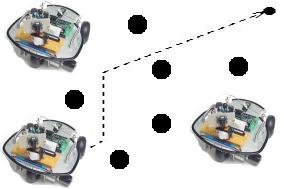Course Information
Syllabus
|
|
Instructor
Mailing list and Forum
Introduction
This is an experimental special topic course discussing how
to reason the real world through a group of mobile
sensors, or how to collaborate with each other to achieve a
better understanding of the real world.
This sounds like a big topic, but we'll narrow it down to
one special area inspired by the behavior of ant colony,
path finding through collaborative processing and obstacle
avoidance through collaborative processing. In ant society,
a shortest path between a nest and a food source can be
found by each ant laying pheromone on its way to attract
other ants. The more the pheromone, the more reinforced the
path.
This sounds like a very difficult problem. Indeed, it is.
But we'll take a babystep toward this area, obstacle avoidance
on the road. That is, a sensor should avoid any obstacles
encountered by other sensor nodes through collaborative
processing. To add an engineering flavor to the course, you
are going to build the mobile sensor node yourself.
Content
Requirements
The course is offered at three different levels, 491 for
undergraduate, 599 for M.S., and 692 for Ph.D. The lectures
are the same, but the project requirement is very
different.
- ECE491:
- Build the mobile sensor node. A starting kit will be
provided to each group. It shouldn't take you more than a
month to build it.

- Each sensor node is able to recognize obstacles
(including the shape, size of the obstacle)
- Final report (assembled from milestone reports) and demo
- One midterm exam
- ECE599:
- Build the mobile sensor node
- Each sensor node is able to recognize obstacles
- Each sensor should be able to inform its neighbors
about the position of the obstacles
- Final report and demo
- One midterm exam
Prerequisite
You should have programming, image processing, computer
networking (for graduate students) and hardware background.
|

